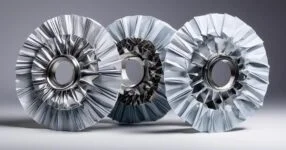The pros of 19-inch wheels are improved handling, better aesthetics, quieter operation, and more responsive steering. A wider tire selection offers versatility for various driving needs and conditions.
The cons of 19-inch wheels are increased tire cost, ride comfort compromise, potential speedometer discrepancy, and impact on fuel efficiency. They wear out faster, provide a harsher ride, and are more vulnerable to potholes.
Takeaways:
- 19-inch wheels enhance vehicle handling, aesthetics, and personalization options.
- Larger wheels may lead to higher tire costs and more frequent replacements.
- Proper maintenance is crucial for the longevity and performance of 19-inch tires.
- Increased wheel size can reduce fuel efficiency and alter the driving experience.
| Pros of 19 Inch Wheels | Cons of 19 Inch Wheels |
|---|---|
| Improved Handling | Increased Tire Cost |
| Better Aesthetics | Ride Comfort Compromise |
| Quieter Ride | Potential Speedometer Discrepancy |
| More Responsive Steering | Impact on Fuel Efficiency |
| Wider Tire Selection | Faster Tire Wear |
| Enhanced Road Holding | Harsher Ride |
| Improved Brake Clearance | More Vulnerable to Potholes |
| Increased Resale Value | Easier to Scuff on Kerbs |
| Better Heat Dissipation | Performance in Wet Conditions |
| Enhanced Vehicle Dynamics | Increased Suspension Wear |
Pros of 19 Inch Wheels
- Improved Handling: The larger diameter of 19-inch wheels allows for a wider tire to be fitted, which in turn provides a larger contact area with the road. This increased contact area improves grip and stability, particularly at higher speeds or when taking corners, making the vehicle feel more secure and responsive.
- Better Aesthetics: Wheels significantly influence a vehicle’s appearance, and 19-inch wheels offer a more aggressive and upscale look compared to smaller options. They fill out the wheel arches more completely, giving the car a more planted and premium appearance that is often associated with high-performance or luxury models.
- Quieter Ride: The design and construction of tires for 19-inch wheels often incorporate advanced noise-reduction technologies. These tires can provide a quieter ride by effectively dampening road noise, which contributes to a more comfortable and enjoyable driving experience.
- More Responsive Steering: The steering response is sharper with 19-inch wheels due to the reduced sidewall flex compared to smaller wheels. This makes the steering feel more precise and direct, allowing for better control and feedback from the road.
- Wider Tire Selection: Owners of vehicles with 19-inch wheels benefit from a wider selection of tire options. This range includes high-performance summer tires, all-season options, and even winter tires, providing flexibility to choose tires that best match their driving needs and conditions.
- Enhanced Road Holding: The larger contact patch of 19-inch tires improves road holding, especially in dry conditions. This can lead to faster acceleration and shorter braking distances, enhancing overall vehicle performance.
- Improved Brake Clearance: Larger wheels offer better accommodation for bigger brake systems, which is a common upgrade for performance-oriented drivers. This allows for improved braking performance, which is crucial for safety and performance driving.
- Increased Resale Value: Vehicles equipped with 19-inch wheels can often command a higher resale value. The enhanced aesthetics and perceived performance benefits make these vehicles more desirable to potential buyers.
- Better Heat Dissipation: The larger air volume inside 19-inch tires can help with better heat dissipation during high-speed driving or under heavy braking conditions. This can reduce the risk of tire blowouts and improve overall tire life.
- Enhanced Vehicle Dynamics: The combination of improved handling, responsiveness, and stability with 19-inch wheels can lead to a more engaging driving experience. Drivers might find the vehicle more enjoyable to drive, particularly on winding roads or during spirited driving sessions.
Cons of 19 Inch Wheels
- Increased Tire Cost: Tires for 19-inch wheels are generally more expensive than those for smaller wheels due to the larger size and often more complex construction. This can lead to higher costs for replacements and maintenance over the life of the vehicle.
- Ride Comfort Compromise: The reduced sidewall height of tires fitted to 19-inch wheels can lead to a harsher ride. This is because there’s less cushioning between the road and the vehicle, resulting in a more pronounced feeling of bumps and imperfections on the road surface.
- Potential Speedometer Discrepancy: Changing wheel sizes can affect the accuracy of the vehicle’s speedometer. If not properly calibrated for 19-inch wheels, the speedometer may display an incorrect speed, which could lead to unintended speeding violations.
- Impact on Fuel Efficiency: The added weight and increased rolling resistance of larger wheels can negatively impact fuel efficiency. Vehicles may consume more fuel, particularly at highway speeds, where the aerodynamic disadvantages of larger wheels are more pronounced.
- Faster Tire Wear: The high-performance tires often fitted to 19-inch wheels can wear out faster than those designed for comfort. The softer compounds used for enhancing grip and handling can lead to increased wear rates, necessitating more frequent tire replacements.
- Harsher Ride: The decreased sidewall flexibility of 19-inch tires can transmit more road vibrations and shocks to the cabin. This can compromise ride quality, making long journeys or driving on poorly maintained roads less comfortable.
- More Vulnerable to Potholes: The thinner cushioning layer of air and rubber between the wheel and the road makes 19-inch wheels more susceptible to damage from potholes, bumps, and road debris. This can lead to costly wheel repairs or replacements.
- Easier to Scuff on Kerbs: The larger diameter and reduced tire sidewall height increase the risk of scuffing or damaging the wheels when parking close to curbs. This cosmetic damage can detract from the vehicle’s appearance and may require expensive repairs.
- Performance in Wet Conditions: While 19-inch wheels may offer improved performance in dry conditions, they can sometimes be at a disadvantage in wet conditions compared to smaller wheels with higher-profile tires. This can result in reduced traction and longer stopping distances when driving on wet roads.
- Increased Suspension Wear: The added weight and stiffer sidewalls of 19-inch tires can lead to increased wear on suspension components. Components such as shocks, struts, and bushings may experience accelerated wear, leading to potential increases in maintenance costs over time.
Enhanced Handling
The adoption of 19-inch wheels significantly elevates a vehicle’s handling dynamics, offering drivers a larger contact patch with the road for superior control. This upgrade not only enhances the car’s ability to negotiate corners with more precision but also improves steering responsiveness, allowing drivers to feel more connected to the driving surface. The benefits of this increased wheel size extend to better stability at higher speeds, which is crucial for maintaining control during high-speed maneuvers.
Moreover, the enhanced cornering abilities facilitated by 19-inch wheels are complemented by the increased traction they provide during both acceleration and braking. This increased traction is a result of the larger wheel’s ability to distribute the vehicle’s weight more evenly across the road surface, thereby improving grip. This is especially beneficial in conditions where maintaining control of the vehicle is paramount, such as wet or slippery roads.
Improved Aesthetics

While enhancing a vehicle’s handling dynamics, 19-inch wheels also significantly elevate its aesthetic appeal, offering a sportier and more aggressive look. This transformation is not just about performance; it’s also about making a statement on the road. The shift towards larger wheel sizes, such as 19 inches, is a trend fueled by the desire to augment the visual presence of a vehicle. These wheels contribute to a more pronounced and stylish stature, ensuring that a car doesn’t just perform well but looks the part too.
The allure of 19-inch wheels isn’t merely in their size but in the variety of unique design options they present. This versatility allows car owners to personalize their vehicles to a great extent, making each car distinct from the next. The ability to customize and choose from an array of designs means that upgrading to 19-inch wheels can revamp the vehicle’s aesthetics profoundly. Such an upgrade ensures that the car not only commands attention with its performance but also with its enhanced visual impact, standing out in a crowd with a commanding presence and a refined, stylish look.
Increased Tire Cost

Opting for 19-inch wheels inevitably leads to higher tire costs due to their larger size and limited availability. This size increase directly correlates to the need for more material in the tire’s construction, which can significantly impact the price. Unlike more common sizes, 19-inch tires are not as widely produced, which can limit options and drive up costs due to supply and demand dynamics. The specialized nature of these tires means that consumers may find themselves paying a premium not just for the initial purchase but also when it comes to replacements.
The financial implications extend beyond the initial investment. Owners of vehicles with 19-inch wheels may find themselves replacing tires more frequently than those with smaller wheels. This is because the options available might not offer the same longevity as those for more common sizes, further increasing maintenance expenses over the vehicle’s lifetime. This repeated cost can quickly add up, potentially offsetting the aesthetic or performance benefits associated with larger wheels. Consequently, while the appeal of 19-inch wheels is undeniable, it’s crucial for consumers to consider the long-term implications of higher tire costs when making their choice.
Ride Comfort Compromise

Selecting 19-inch wheels often results in a compromise on ride comfort due to their reduced sidewall height and larger diameter. This configuration, while aesthetically pleasing and offering certain handling advantages, tends to diminish the cushioning effect against bumps and road imperfections that smaller wheels with higher sidewalls provide.
The reduced sidewall height that accompanies larger wheels like the 19-inch variety means there is less tire to absorb shock, leading to a harsher ride quality. As these wheels transmit more road vibrations and imperfections directly to the vehicle, passengers may experience increased discomfort during travel, especially on less-than-ideal road surfaces.
The decision to opt for 19-inch wheels should, therefore, be carefully weighed against the potential drawbacks in ride comfort. While these wheels can enhance a vehicle’s handling and contribute to a sportier look, the trade-off often involves a noticeable decrease in the smoothness of the ride. Enthusiasts drawn to the improved aesthetics and performance characteristics of larger wheels must consider whether these benefits justify the compromise in overall comfort.
This balance between performance and comfort is a crucial aspect of the decision-making process for drivers contemplating the switch to 19-inch wheels.
Potential Speedometer Discrepancy

When opting for 19-inch wheels, one significant aspect to consider is the potential speedometer discrepancy that arises due to the larger diameter of the wheels. This alteration can lead to a speedometer reading that is lower than the vehicle’s actual speed, thus impacting the accuracy of speed measurements.
To ensure correct speedometer readings, recalibration may be necessary, which involves consulting with a professional or referring to the manufacturer’s guidelines.
Accuracy Impact
Switching to 19-inch wheels often results in a speedometer discrepancy of up to 3-4%, due to the increased diameter affecting the vehicle’s speed calculations. This discrepancy arises from the larger wheels having a greater circumference, which alters the rotation per mile calculation essential for accurate speed readings.
Consequently, drivers may observe their speedometer displaying a higher speed than the vehicle’s actual speed. This variance not only affects the vehicle’s speedometer accuracy but also impacts driving habits and the driver’s awareness of their actual speed.
Drivers must adjust their perception of speed to accommodate this discrepancy, ensuring they are not inadvertently exceeding speed limits or misjudging their speed during travel, thereby affecting safety and compliance with traffic regulations.
Calibration Requirements
Upgrading to 19-inch wheels necessitates speedometer recalibration to correct discrepancies caused by the larger diameter, ensuring accurate vehicle speed readings. The change to a larger wheel size increases the circumference of the tire, directly affecting how the vehicle calculates speed.
This discrepancy, if not corrected, can render speedometer readings inaccurate, leading to potential legal issues due to unintentional speeding. Recalibrating the speedometer is thus crucial for maintaining the vehicle’s functionality and adherence to traffic laws.
Vehicle owners are advised to consult with professionals or refer to the vehicle’s manual for proper guidance on recalibrating the speedometer when transitioning to 19-inch wheels, ensuring the accuracy of speed readings and the overall safety of the driving experience.
Wider Tire Selection

Exploring the variety of tire options, 19-inch wheels stand out for their wide selection, catering to diverse driving preferences and needs. This advantage is significant, as it opens up a broad spectrum of tire brands and types, allowing vehicle owners to tailor their ride’s performance to their exact specifications. The availability of different tread patterns and rubber compounds is particularly beneficial, as these factors are crucial in meeting specific driving requirements, whether for improved grip, enhanced durability, or better wet-weather performance.
Moreover, the wider tire selection associated with 19-inch wheels facilitates a more nuanced approach to balancing performance, comfort, and all-season capabilities. Drivers can choose tires that offer a quiet, comfortable ride, those that provide sharper handling and responsiveness, or tires designed to perform optimally in a wide range of weather conditions. This flexibility is a considerable advantage, enabling an optimized driving experience tailored to individual preferences and the demands of varying driving environments.
Selecting the appropriate tires for 19-inch wheels is not just about aesthetics; it significantly influences handling and the overall driving experience. The right choice can enhance the vehicle’s performance, safety, and enjoyment, making the wider tire selection of 19-inch wheels a compelling feature for discerning drivers.
Impact on Fuel Efficiency

Often overlooked, the impact of 19-inch wheels on fuel efficiency can be significant, stemming from the increased rotational mass they introduce. The choice to upgrade to larger wheels is often driven by aesthetic or performance considerations, but the implications for fuel economy cannot be ignored. As vehicles are tasked with moving heavier wheels, the engine requires more energy, which can lead to an uptick in fuel consumption. This effect is nuanced and varies depending on several factors.
- Increased Rotational Mass: Larger 19-inch wheels contribute to increased rotational mass, requiring more energy for movement, thus potentially reducing fuel efficiency.
- Driving Style and Habits: Aggressive driving behaviors, such as rapid acceleration and braking, are exacerbated by larger wheels, further decreasing fuel economy.
- City Commutes: Short, stop-and-go city driving with 19-inch wheels can lead to lower miles per gallon (MPG) due to frequent acceleration and deceleration.
- Aggressive Driving Behaviors: High-speed driving and rapid acceleration contribute more significantly to decreased fuel economy when larger wheels are involved.
- Terrain and Driving Conditions: Hilly terrain and adverse driving conditions can further impact fuel efficiency negatively with larger wheels, as more power is often required to maintain speed and stability.
Understanding these factors can help drivers make informed decisions about wheel size and its potential impact on fuel efficiency.
Conclusion
In conclusion, the decision to equip a vehicle with 19-inch wheels entails a careful consideration of both advantages and disadvantages.
While these wheels offer improved handling and aesthetics, contributing to a sportier and more aggressive vehicle appearance, they also bring potential downsides such as increased tire costs, compromised ride comfort, possible speedometer discrepancies, a wider but more expensive tire selection, and an impact on fuel efficiency.
Therefore, potential buyers must evaluate these factors in alignment with their driving preferences and requirements.










